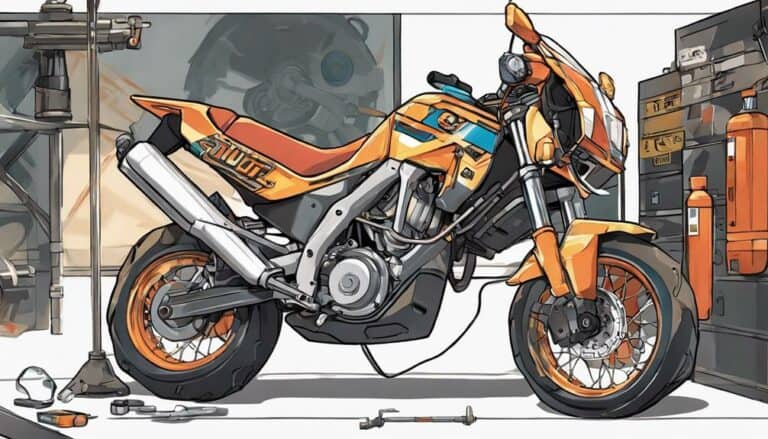When contemplating how to gauge your dirt bike's fuel line size, precision is paramount. Ensuring the right fit can prevent potential issues down the road, from leaks to performance problems.
But how do you accurately ascertain the dimensions without causing any disruptions? The methodical approach and the proper tools are key in this process.
By taking the time to master this fundamental task, you equip yourself with the knowledge essential for maintaining your bike's fuel system integrity.
Key Takeaways
- Use specific tools like a 1/4-inch wrench or calipers for accurate fuel line diameter measurement.
- Maintaining correct fuel line size is crucial for proper bike operation and fuel flow.
- Fuel lines are typically around 6mm ID, crucial for installation and engine performance.
- Regular inspection and adherence to maintenance schedules are essential for fuel line quality.
Types of Fuel Lines
When selecting fuel lines for your dirt bike, it's important to contemplate the various types available to guarantee peak performance and safety. Fuel lines are typically constructed from either rubber or synthetic materials, each offering distinct advantages. Rubber fuel lines are commonly found in older dirt bike models and are known for their flexibility and durability. However, synthetic materials such as nylon or polyurethane have gained popularity due to their resistance to swelling and deterioration from fuel exposure.
Understanding the manufacturer specifications for the correct fuel line size is essential. Different dirt bike models may require specific line sizes to ensure proper fuel flow and prevent potential issues. Using fuel lines that don't meet the manufacturer's recommendations can lead to inefficiencies in the engine's performance or even leaks.
Before replacing or upgrading your fuel line, always refer to the manufacturer specifications to determine the appropriate size and material for your dirt bike. This attention to detail will help maintain peak fuel flow and overall engine health.
Tools Required for Measurement
To accurately measure the size of your dirt bike fuel line, you'll require specific tools such as a 1/4-inch wrench or calipers for precise measurements. The 1/4-inch wrench is used by placing it over the fuel line and reading the measurements to determine the line size.
On the other hand, calipers can be utilized by adjusting the tips to fit tightly on both sides of the fuel line and then measuring the diameter accurately. These tools make sure that you obtain precise measurements, which are important for maintenance and replacement purposes.
Comparing the fuel line to others can also provide a rough estimate of its size for measurement. Making sure the correct tools are used guarantees accuracy in determining the fuel line diameter, enabling you to select the appropriate replacement or conduct maintenance effectively.
Step-by-Step Measurement Process
For an accurate measurement of your dirt bike fuel line size, begin by utilizing a 1/4-inch wrench to firmly fit over the tubing, measuring the outer diameter. Make sure the wrench fits securely without any gaps to get a precise measurement. If needed, adjust calipers to securely measure the fuel line. Compare the caliper tips on a ruler to determine the outer diameter accurately.
Remember not to disconnect the fuel line to prevent leaks or damage during the measurement process. To estimate the size, visually compare the fuel line with other known sizes. Maintaining the correct fuel line size is essential for proper maintenance and replacement, ensuring the efficient operation of your dirt bike.
Understanding Fuel Line Sizing
Have you ever wondered how the correct fuel line size plays a pivotal role in maintaining the peak performance of your dirt bike engine? When it comes to dirt bikes, the fuel line size is typically around 6mm ID, falling between 7/32 and 1/4, with slight variations among different makes and models. While using a slightly smaller fuel line won't adversely affect engine performance, it can greatly impact ease of installation. Confirming the correct fuel line size is vital for maintenance and replacement to make sure proper fuel flow. Different dealerships and parts suppliers may have varying approaches to providing the correct fuel line for dirt bikes. To accurately measure the diameter of the fuel line for replacement, tools like calipers or a wrench can be utilized.
| Aspect | Details |
|---|---|
| Typical Size | Around 6mm ID, between 7/32 and 1/4, varies by make/model |
| Impact on Engine | Slightly smaller line won't affect performance, affects installation |
| Importance | Vital for maintenance and replacement to make sure fuel flow |
Tips for Maintaining Fuel Line Quality
Maintaining prime fuel line quality on your dirt bike requires regular inspection and adherence to recommended maintenance schedules.
The diameter of the fuel line is determined by the inner diameter (ID) of the tubing. To guarantee accurate measurement, use a combination wrench to measure the outer diameter (OD) of the fuel line. Make sure the wrench fits snugly over the tubing for precise readings.
Different industries may have unique measurement standards for tubing and pipe, so it's essential to follow guidelines specific to dirt bikes.
Proper fuel line size is essential for the efficient operation of your bike, as it directly impacts fuel flow and engine performance.
By monitoring the inner and outer diameters of the tubing and conducting routine checks, you can maintain prime fuel line quality and prevent potential issues while riding.
Regular maintenance of the fuel line ensures a smooth and reliable dirt biking experience.
Conclusion
In summary, accurately measuring your dirt bike fuel line size is vital for proper maintenance and replacement.
By using the right tools and techniques, such as calipers or a 1/4-inch wrench, you can guarantee a precise measurement without disconnecting the fuel line.
Remember, a well-fitted fuel line is the lifeblood of your dirt bike, so make sure to measure it with precision to keep your ride running smoothly like a well-oiled machine.

